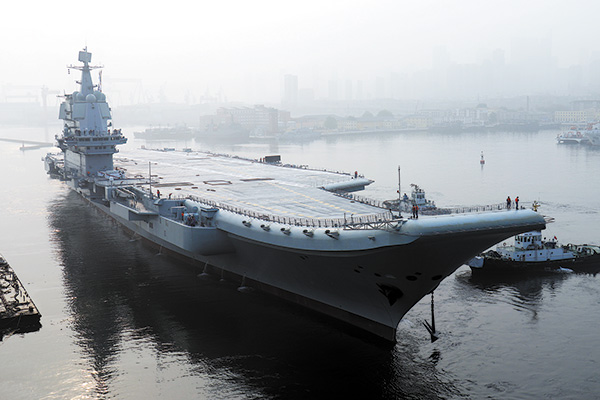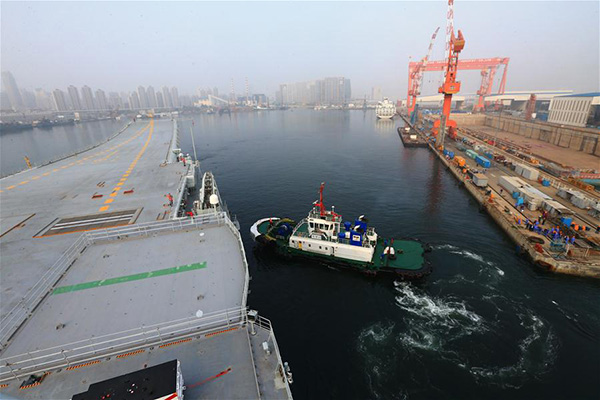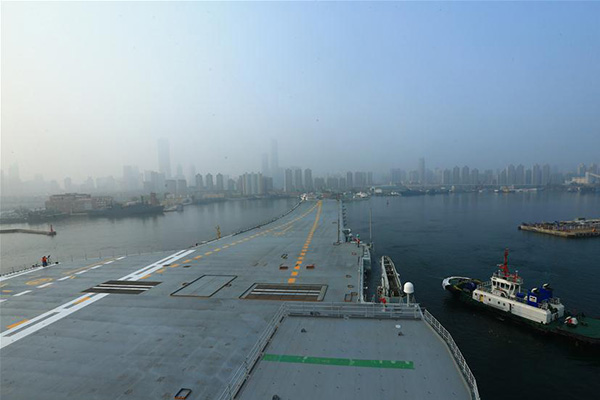
China’s first domestically designed aircraft carrier, which displaces 50,000 metric tons, leaves the Dalian Shipbuilding Industry’s shipyard in Liaoning province on May 13.[Photo/China Daily]
China’s first domestically designed aircraft carrier set out its maiden sea trial on the morning of May 13, indicating it might not be long before it is delivered to the Chinese Navy.
The colossal vessel, which displaces 50,000 metric tons, left the Dalian Shipbuilding Industry’s shipyard in Liaoning province about 7 a.m. amid thick fog with the assistance of several tugboats before navigating into the sea under its own power.
The People’s Liberation Army Navy said in a statement the trial aims to demonstrate the reliability and capability of the ship’s propulsion systems, adding its construction has been proceeding well.
Hu Wenming, chairman of China Shipbuilding Industry Corp, parent of Dalian Shipbuilding and chief of the new carrier program, told China Central Television that the new vessel is one of the advanced carriers in the world and its construction has strengthened the country’s research and development capability regarding aircraft carriers.
The new carrier’s name and hull code remain unknown, as the PLA usually only makes public such information when a ship is commissioned.
According to the Navy, the commander of the new carrier is Senior Captain Lai Yijun. Lai is reported to have been captain of CNS Lianyungang guided-missile frigate, commander of a frigate flotilla and then executive officer of CNS Liaoning aircraft carrier.
The ship, the largest and most sophisticated naval vessel in China, was designed and built by the nation on its own.

China’s first home-built aircraft carrier leaves Dalian in Northeast China’s Liaoning province for sea trials on May 13, 2018.[Photo/Xinhua]
Its construction began in November 2013, and work in the dry dock began in March 2015. The carrier was launched-moved into water-in April 2017. By now its outfitting-during which engineers installed and fine-tuned all interior equipment and weapons-has been completed.
Gao Zhuo, a military analyst in Shanghai who follows China’s aircraft carrier programs, said that after the first sea trial, more trials will follow to verify the carrier’s maximum speed, resistance to different sea conditions, electronics and weapons systems as well as the compatibility of aircraft and aviation-support devices.
He said the vessel will be better than China’s other aircraft carrier, the CNS Liaoning, when it comes to deploying and supporting fighter jets in combat thanks to designs by Chinese engineers.
Cui Yiliang, editor-in-chief of Modern Ships magazine, said the new carrier’s sea trials will be like those of the Liaoning, and the total time needed for the trials may be slightly shorter than the Liaoning’s because Navy personnel have had experience obtained through the Liaoning’s operations.
The Liaoning was originally a Soviet-era vessel and was extensively refitted at the Dalian shipbuilder. The vessel conducted 10 sea trials starting in August 2011 before going into service in September 2012.
The new carrier has a conventional propulsion system. Like the Liaoning, it will use a ramp to launch J-15 fighter jets, the spearhead of China’s carrier battle group. The ship also will carry several types of helicopters.

China’s first home-built aircraft carrier leaves Dalian in Northeast China’s Liaoning province for sea trials on May 13, 2018.[Photo/Xinhua]
The new carrier has more than 12,000 pieces of equipment that were made by 532 Chinese enterprises, including many private firms, according to officials from China Shipbuilding Industry Corp. They said the vessel has more than 3,600 cabins, noting that during construction, there would be at least 3,000 workers from across the country working on the ship each day.
According to sources from the Navy, several aspects on the new carrier are different from those on the Liaoning-the new ship’s island (the towering section of the ship) is shorter than that of the Liaoning; it has three aircraft arresting wires (brakes) instead of four on the Liaoning; and the landing section is longer than the Liaoning’s, among other differences.
Experts have said that the new carrier will have missions that differ from those of the Liaoning, which is mainly tasked with testing equipment and weapons and training personnel. The new vessel, by comparison, will focus on what a genuine aircraft carrier is supposed to do: run combat-ready patrols and safeguard the nation’s maritime sovereignty and interests.
Zhang Junshe, a researcher with the PLA Naval Military Studies Research Institute, said the Chinese Navy needs at least three aircraft carriers. When it has that many, one can be on duty, one can train personnel and the third can take on maintenance, he said.
Besides China, seven countries-the United States, Russia, Britain, France, Italy, Thailand and India-operate a total of 18 aircraft carriers. The US is the largest operator, with 11 nuclear-powered carriers, each having a full-load displacement of about 100,000 tons.
